The Gamewell Company
Reprinted from "Crown Jewels of the Wire", February 1989, page 17
The tremendous fire losses of the early days of this country were due not
only to primitive fire lighting equipment and inferior building construction
with flammable materials, but in a very large degree to the entire absence of
facilities for quickly announcing the existence and locations of fires.
New York
City was the first community to attempt providing means for announcing by some
systematic method the locations of fires. In 1845 the city was divided into fire
districts. A watchtower and bell was provided in each district, and a watchman
was on duty in each tower at all times. Each district was numbered so that when
these numbers were sounded on the tower bells, the members of the volunteer fire
companies, and the general public as well, were informed of the section of the
city in which the fire existed.

Sounding an alarm by this method was a slow and
tedious process. If a watchman in a tower discovered a fire in his district, he
would strike the number of his tower on the bell, manually. This signal would be
heard by the watchman on the next tower and he would repeat the signal. In this
manner the alarm was spread, step by step, gradually to the entire city. Fire
discovered within a building where it could not be observed by a watchman was
announced by the occupants running to the watch tower, and shouting, "FIRE!"
The necessity for a swift and reliable means for announcing alarms
of fire had long been recognized, but not until after the invention of the Morse
telegraph did the problem approach solution. The earliest suggestion of the
application of the telegraph to fire alarm signaling was made by Dr. William F.
Channing in an article published in THE BOSTON ADVERTISER in 1845, which
described his method of transmitting to the watch towers, coded signals from
distinctively numbered street stations and automatically striking these signals
on the tower bells by means of electro-mechanical bell strikers.
In working out
his plan, Dr. Channing associated himself with Moses G. Farmer, then a telegraph
operator at Framingham, and during the year 1847 and the year following, the
first practical fire alarm telegraph system was developed. The first
installation was made in Boston in the year 1851, and Moses G. Farmer became the
first superintendent of fire alarm in Boston. The first actual alarm was
transmitted over the new system in 1852. This, the first practical fire alarm
system, had its birth in Massachusetts.
Three years later in 1855, John N.
Gamewell of South Carolina, became convinced of the possibilities inherent in
Boston's first experimental system, and purchased from Channing and Farmer the
rights to use their inventions in the southern states. Four years after that he
purchased all their patents, and actual manufacturing was begun in 1866 immediately after the close of the
Civil War.
The fire alarm telegraph circuit employed in the first installation
in 1851 was of the closed metallic type, therefore under constant supervision
and any interruption caused a warning signal to be given calling attention to its
disabled condition. In this one respect the Gamewell system has remained
unchanged. The original fire alarm box was a comparatively crude device, consisting
merely of a wooden case with a hinged door enclosing a crank handle
with a notched wheel, a set of electrical contacts, and a small bell or tapper.
Turning the handle slowly caused the opening and closing of the contacts and the
transmission to the fire department of the code number created by the notches on
the wheel.
This method placed too much dependence on the human element and was
soon superceded by a clockwork mechanism which required but a simple movement of
a lever to be set in motion, after which the transmission of a alarm was
automatically performed at a uniform speed.
Then followed a long series of
developments, chief among which were the application of the noninterference
principle which prevented any loss or mutilation of alarms by reason of two or
more boxes on a circuit being operate simultaneously or while a box was engaged
in the transmission of a signal; the principle of succession which provided for
the consecutive transmissions of such alarms; and the automatic grounding
feature which provides for the correct reception of alarms from either side of
a broken or otherwise disabled circuit.
These features, together with automatic
reception, announcement and recording with the exact time and date at the
central station, automatic retransmission of alarms to fire stations, including
visual and audible announcement to the fire fighting forces, are all standard
functions of the modern Gamewell municipal fire alarm system.
Gamewell fire alarm systems are installed today in many countries all over the globe, and
one out
of ten systems in the United States and Canada are Gamewell.
Fire alarm systems
are by no means the whole story of the Gamewell organization's manufacturing
activities. Gamewell is also the world's largest producer of police signaling
systems.
The Gamewell police signaling system has long been recognized as a
highly efficient aid to municipal police organizations. The system came into
existence as a natural outgrowth of the Gamewell fire alarm telegraph system.
Police departments were quick to recognize the value of this means of
communication and by arrangement with fire departments began to have code
signals set aside for police use exclusively. At first these signals consisted of a certain number of blows struck on the fire bells, indicating that
the members of the police department were to proceed immediately to headquarters
or some other point of assembly.
Later dial telegraphs for transmitting code
signals from station to station and various other applications of the Morse
telegraph were applied to police service. These devices were limited in accomplishment, but in 1880 the
combination of the telephone and the Gamewell multiple signal mechanism provided
a highly efficient basis for the modern system of police communications.
In
its long history the Gamewell Company moved several times. In 1911 New York
operations were moved to Newton Upper Falls, Massachusetts. In 1973 the company
moved to Medway, Massachusetts and in 1988 sales, marketing and engineering
were moved to Franklin, Massachusetts, while manufacturing remains in Medway.
FIRE ALARM BOXES IN SERVICE
GAMEWELL DESIGNS
MATERIALS EMPLOYED: The materials used in fire alarm box cases are stated as
follows in chronological order:
Outside Cases: Cast iron until 1928. Die cast silicon--aluminum alloy--trade
name "Herculite", thereafter.
Inside Cases: Cast iron until 1922. Porcelain enamel, 1922-1928. Bakelite,
1928-1929. "Herculite" since 1929.
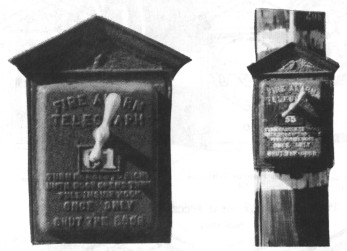
Early Gamewell Fire Alarm boxes are
the keyless door type found still in
service
in Montpelier, Vermont.
KEYLESS DOORS
With Local Alarm Bell, Manually Operative
NOTE: Parts for keyless doors are no longer available but doors may be
replaced by the modern quick-action type -- with or without Arrestolarms -- the local
alarm devices now employed to discourage false alarms.



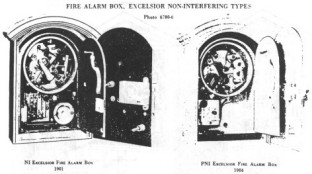
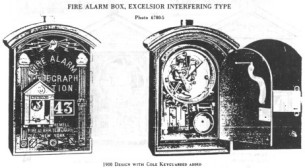


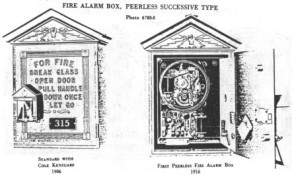
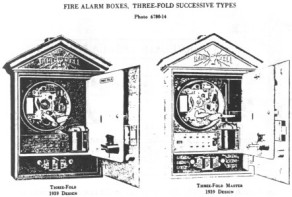
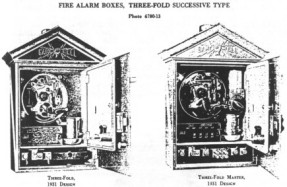
| 